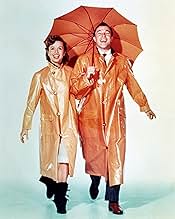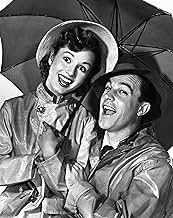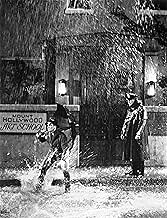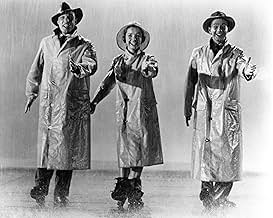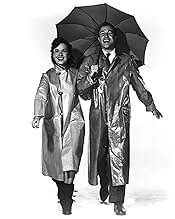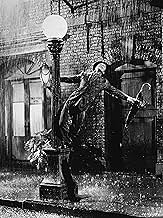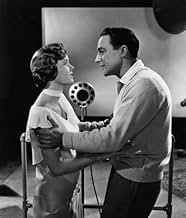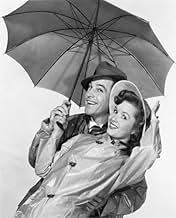A silent film star falls for a chorus girl just as he and his delusionally jealous screen partner are trying to make the difficult transition to talking pictures in 1920s Hollywood.A silent film star falls for a chorus girl just as he and his delusionally jealous screen partner are trying to make the difficult transition to talking pictures in 1920s Hollywood.A silent film star falls for a chorus girl just as he and his delusionally jealous screen partner are trying to make the difficult transition to talking pictures in 1920s Hollywood.
- Directors
- Writers
- Stars
- Nominated for 2 Oscars
- 11 wins & 11 nominations total
Dawn Addams
- Teresa - a Lady-in-Waiting
- (uncredited)
John Albright
- Call Boy
- (uncredited)
Shirlee Allard
- Chorus Girl
- (uncredited)
Bebe Allen
- Chorus Girl
- (uncredited)
Sue Allen
- Chorus Girl
- (uncredited)
John Angelo
- Dancer
- (uncredited)
Marie Ardell
- Chorus Girl
- (uncredited)
David Bair
- Chorus Boy
- (uncredited)
Jane Bateman
- Chorus Girl
- (uncredited)
- Directors
- Writers
- All cast & crew
- Production, box office & more at IMDbPro
Summary
Reviewers say 'Singin' in the Rain' is a celebrated classic, praised for its charm, wit, and infectious energy. Gene Kelly's performance, especially in the title number, is lauded for its seamless blend of dancing, singing, and charisma. The supporting cast, including Debbie Reynolds and Donald O'Connor, is commended for their stellar performances and chemistry. The film's vibrant choreography, clever script, and memorable musical numbers are frequently celebrated. Despite minor criticisms about predictability and humor, it remains a beloved musical.
Featured reviews
It's the magic that seldom appears, whose longevity is perpetual, the pleasure of enjoying the perfections that people, music and great storytelling can sometimes offer, with the backdrop a little piece of cinema history itself. All without foul language, extravagant pyrotechnics, mass brawls and bullets ricocheting all over the place, just immensely talented people doing what they do best - keeping you entertained and allowing you to escape for a while and live with the dreams of others. Whether musicals are you thing or not, there can be no doubt that you witness greatness as you welcome the rain and it makes your heart sing.
I don't like musicals. They never made any sense to me. Don't get me wrong, I love music; it's an important part of my life. I love movies also, and while the two often compliment each other, sometimes I'm repelled. It's probably the dancing. A person breaking into a complicated dance number, seemingly unaware of their surroundings, or worse yet, in complete synch with a complete stranger is like making fun of the movie, as if to say, "Please don't take us seriously, we like to sing and dance." Or even more ridiculous, "Let's not fight, let's settle this dispute with a song and dance." Forget about suspension of disbelief.
This film however, I manage to enjoy. I once was given the task of my film teacher to watch the film and keep track of all the cuts in the film. Well, sometime after ten minutes I lost track because I was so wrapped up in the story. It really is an interesting period in the history of cinema, told well, and with well placed song and dance numbers that at times drag on, but that seems to be more of an excuse to show off the technicolour than anything else. They build you up to it slowly. The first few numbers don't break out at an inappropriate time. It doesn't last though, but by then they've got you.
With such memorable tunes as these, it's hard to imagine them going wrong. When Gene Kelly sings the title piece, somehow time stands still as you're swept up in one of the most memorable scenes in film history. Just reading the title in print has likely caused you to hum a few bars, or sing a few words. Or maybe, just maybe, walk out without an umbrella when you know it's raining. One thing's for sure, if all Gene Kelly did was choreograph the dance numbers, he more than deserves the co-directing credit he has.
They simply don't make films like this anymore. Which in some ways is a testament to the film's theme and narrative. The business of show is constantly in a state of evolution. The narrative portrays a time period when silent films were being replaced by "talkies" with sound, yet the musical genre itself has almost all but disappeared with the exception of animated films with musical numbers, and rare live-action pieces.
One might speculate that Hollywood overdid the musical. Personally, I can't get into them. Most of the time it seems like a drawn out affair, but this film is something special. Considering my feelings about musicals, it would have to take a film of this one's caliber to make me sit up and take notice.
This film however, I manage to enjoy. I once was given the task of my film teacher to watch the film and keep track of all the cuts in the film. Well, sometime after ten minutes I lost track because I was so wrapped up in the story. It really is an interesting period in the history of cinema, told well, and with well placed song and dance numbers that at times drag on, but that seems to be more of an excuse to show off the technicolour than anything else. They build you up to it slowly. The first few numbers don't break out at an inappropriate time. It doesn't last though, but by then they've got you.
With such memorable tunes as these, it's hard to imagine them going wrong. When Gene Kelly sings the title piece, somehow time stands still as you're swept up in one of the most memorable scenes in film history. Just reading the title in print has likely caused you to hum a few bars, or sing a few words. Or maybe, just maybe, walk out without an umbrella when you know it's raining. One thing's for sure, if all Gene Kelly did was choreograph the dance numbers, he more than deserves the co-directing credit he has.
They simply don't make films like this anymore. Which in some ways is a testament to the film's theme and narrative. The business of show is constantly in a state of evolution. The narrative portrays a time period when silent films were being replaced by "talkies" with sound, yet the musical genre itself has almost all but disappeared with the exception of animated films with musical numbers, and rare live-action pieces.
One might speculate that Hollywood overdid the musical. Personally, I can't get into them. Most of the time it seems like a drawn out affair, but this film is something special. Considering my feelings about musicals, it would have to take a film of this one's caliber to make me sit up and take notice.
Many good things can be and have been said about this one and they're all true. It's a great movie. The title number gives us Don Lockwood (Kelly)...In love as no other person has ever been in love, no doubt. He steps out the door and it's raining but he's oblivious to the rain. Who needs an umbrella when you've got wings on your heart and on your feet? Not the incomparable Gene Kelly as he treats us to THE single finest moment in the history of cinema. Do not miss this one.
One thing I noticed in reading the comments of this movie is that nobody recognized the screenplay by Betty Comden and Adolph Green. Without their screenplay the movie does not get made. It is a great script that was made better by Gene Kelly and Stanley Donens' fluid direction. Everything in this movie glides effortlessly. Throw in dancing by Donald O'connor, Debbie Reynolds, Cyd Charisse and of course Gene Kelly, Great songs and the willingness of producer Arthur Freed to let the creative people to do their thing and you have a classic.
Don Lockwood (Gene Kelly) and Lina Lamont (Jean Hagen) are a famed Hollywood duo, making films at the tail end of the silent era. The studio has been issuing PR suggesting that they're a romantic item. In reality, they can barely stand one another. One night, while on the town with his best friend Cosmo Brown (Donald O' Connor), Lockwood has to run to escape fans who want a piece of him badly enough that they'll literally rip his clothes to shreds. He hops over a number of moving vehicles and ends up in the passenger seat of Kathy Selden's (Debbie Reynolds) car. Lockwood seems immediately taken with her, but she gives him the cold shoulder. She says she's an actress with a love of theater, and she looks down on film acting. Later, Lockwood discovers that she was inflating the truth a bit, as he sees Selden performing as a cute song & dance girl at an industry party he's attending. She runs out of the party and Lockwood chases after her, but he's too late. While he tries to track her down, he, Lamont and their studio have to deal with the changing nature of film in 1927--made much more difficult by the fact that Lamont may look glamorous, but she talks more like Fran Drescher in "The Nanny" (1993).
Aside from the more serious aspects of the plot, Singing in the Rain is a great success as a romance and a musical. It also has an astoundingly rich Technicolor look, and it is charmingly humorous. Kelly and Reynolds click on screen, even if offscreen Kelly, who also co-directed and co-choreographed, was famously difficult to work with--he drove Reynolds so hard (she was a much more inexperienced dancer) that her feet literally started bleeding at one point. The songs are great, they're worked into the story well--which is perhaps surprising given that most of them weren't written specifically for this film--and the choreography is impeccable, frequently jaw dropping and always aesthetically wondrous and sublime. If for nothing else, the film is worth a look for its often-athletic dance numbers, which can resemble Jackie Chan's showy martial arts stunts as much as dancing. It's also imperative viewing for cultural literacy in the realm of film.
But the more serious aspects of the plot are fascinating as well. In a significant way, Singing in the Rain is about film technology. Film technology is the hinge of the plot, after all. The climax and dénouement are decided by the advent of synchronized sound in the film industry. We see studio head R.F. Simpson (Millard Mitchell) demonstrating sound films at the party where Lockwood sees Selden for the second time, providing two big turning points at once. There are sequences of actors heading off to diction coaches, as happened in reality once sound entered the scene, and also in reality as in the film some actor's careers were jeopardized by having to suddenly master a new skill.
But Singing in the Rain is about technology on another level, too. Kelly and co-director Stanley Donen go to great lengths to ensure that the film is an exemplar of state-of-the-art film technology in 1952. For example, the beautiful Technicolor cinematography is emphasized by the fabulously colorful costumes and production design--they're showing off cutting edge color. The sound is as good as it could be in 1952, and the fact that this is a musical helps show that off. The sets and effects are complex and an attempt is made to show them off as well.
Donen and Kelly often play up the artificiality of the sets and effects to emphasize artistry and technology. This is clearly shown in the "Make 'Em Laugh" sequence (and surrounding events) and the extended "Broadway Rhythm Ballet" sequence with Cyd Charisse. Showing off this artistry and technology also occurs very subtly, as with the rain in the "Singing in the Rain" sequence. Even today, rain machines are frequently employed in a way that it appears to be raining on film, but in reality, it's just enough coverage to produce the illusion. In the "Singing in the Rain" sequence, they make sure that you can see the whole area is getting flooded, and they use Gene Kelly's umbrella, as torrents of water bounce off of it, to emphasize that no matter where he goes, "rain" is pouring down on him.
While there are many musicals I like as much as Singing in The Rain, this is one of the better-loved examples of that genre, and for good reason. Any musical lover has surely seen this already, and if not, they should run out now and pick it up on DVD. If you're relatively unfamiliar with classic Hollywood musicals, this is one of the best places to start.
Aside from the more serious aspects of the plot, Singing in the Rain is a great success as a romance and a musical. It also has an astoundingly rich Technicolor look, and it is charmingly humorous. Kelly and Reynolds click on screen, even if offscreen Kelly, who also co-directed and co-choreographed, was famously difficult to work with--he drove Reynolds so hard (she was a much more inexperienced dancer) that her feet literally started bleeding at one point. The songs are great, they're worked into the story well--which is perhaps surprising given that most of them weren't written specifically for this film--and the choreography is impeccable, frequently jaw dropping and always aesthetically wondrous and sublime. If for nothing else, the film is worth a look for its often-athletic dance numbers, which can resemble Jackie Chan's showy martial arts stunts as much as dancing. It's also imperative viewing for cultural literacy in the realm of film.
But the more serious aspects of the plot are fascinating as well. In a significant way, Singing in the Rain is about film technology. Film technology is the hinge of the plot, after all. The climax and dénouement are decided by the advent of synchronized sound in the film industry. We see studio head R.F. Simpson (Millard Mitchell) demonstrating sound films at the party where Lockwood sees Selden for the second time, providing two big turning points at once. There are sequences of actors heading off to diction coaches, as happened in reality once sound entered the scene, and also in reality as in the film some actor's careers were jeopardized by having to suddenly master a new skill.
But Singing in the Rain is about technology on another level, too. Kelly and co-director Stanley Donen go to great lengths to ensure that the film is an exemplar of state-of-the-art film technology in 1952. For example, the beautiful Technicolor cinematography is emphasized by the fabulously colorful costumes and production design--they're showing off cutting edge color. The sound is as good as it could be in 1952, and the fact that this is a musical helps show that off. The sets and effects are complex and an attempt is made to show them off as well.
Donen and Kelly often play up the artificiality of the sets and effects to emphasize artistry and technology. This is clearly shown in the "Make 'Em Laugh" sequence (and surrounding events) and the extended "Broadway Rhythm Ballet" sequence with Cyd Charisse. Showing off this artistry and technology also occurs very subtly, as with the rain in the "Singing in the Rain" sequence. Even today, rain machines are frequently employed in a way that it appears to be raining on film, but in reality, it's just enough coverage to produce the illusion. In the "Singing in the Rain" sequence, they make sure that you can see the whole area is getting flooded, and they use Gene Kelly's umbrella, as torrents of water bounce off of it, to emphasize that no matter where he goes, "rain" is pouring down on him.
While there are many musicals I like as much as Singing in The Rain, this is one of the better-loved examples of that genre, and for good reason. Any musical lover has surely seen this already, and if not, they should run out now and pick it up on DVD. If you're relatively unfamiliar with classic Hollywood musicals, this is one of the best places to start.
Did you know
- TriviaFor the "Make 'em Laugh" number, Donald O'Connor revived a trick he had done as a young dancer: running up a wall and completing a somersault. The number was so physically taxing that O'Connor ended up in a hospital bed for a week after its completion. He suffered from exhaustion and carpet burns. After an accident ruined all of the initial footage, O'Connor agreed to do the difficult number all over again.
- GoofsDuring the Cyd Charisse nightclub dance number, when she's wrapped around Gene Kelly, her body completely changes position between frames due to a clumsy edit. According to commentary on the special edition DVD, this cut of only a few frames' duration dates back to the original release of the film and no one knows why it exists.
- Quotes
Cosmo Brown: Lina. She can't act, she can't sing, she can't dance. A triple threat.
- ConnectionsEdited from The Three Musketeers (1948)
- SoundtracksFit as a Fiddle
(1932)
Music by Al Hoffman (uncredited) and Al Goodhart (uncredited)
Lyrics by Arthur Freed
Originally from the 1932 stage revue "George White's Music Hall Varieties"
Sung by Gene Kelly (uncredited) and Donald O'Connor (uncredited)
Details
- Release date
- Country of origin
- Language
- Also known as
- Cantando bajo la lluvia
- Filming locations
- Metro-Goldwyn-Mayer Studios - 10202 W. Washington Blvd., Culver City, California, USA(New York City Streets)
- Production company
- See more company credits at IMDbPro
Box office
- Budget
- $2,540,800 (estimated)
- Gross US & Canada
- $1,884,537
- Opening weekend US & Canada
- $13,643
- Nov 10, 2002
- Gross worldwide
- $2,096,442
- Runtime1 hour 43 minutes
- Color
- Sound mix
- Aspect ratio
- 1.37 : 1
Contribute to this page
Suggest an edit or add missing content








